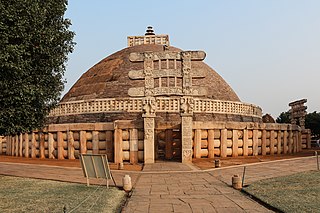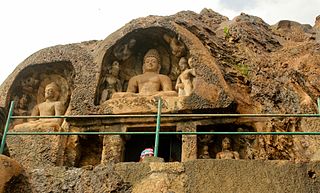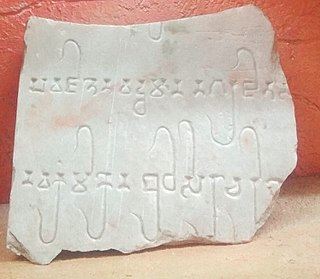
Bodh Gayā is a religious site and place of pilgrimage associated with the Mahabodhi Temple complex, situated in the Gaya district in the Indian state of Bihar. It is famous for being the place where Gautama Buddha is said to have attained enlightenment under what became known as the Bodhi Tree. Since antiquity, Bodh Gayā has remained the object of pilgrimage and veneration, for both Hindus and Buddhists. In particular, archaeological finds, including sculptures, show that the site was in use by Buddhists since the Mauryan period. Bodh Gayā and the nearby regions were invaded and destroyed in the 12th century CE by Muslim Turk armies, led by Delhi Sultanate's Qutb al-Din Aibak and Bakhtiyar Khilji.

In Buddhism, a stupa is a mound-like or hemispherical structure containing relics that is used as a place of meditation.

Vikramashila was a Buddhist monastery situated in what is now modern-day Bihar in India. It was founded by King Dharmapala between the late eighth and early ninth century.

Amaravathi is a village located on the banks of the Krishna River in the Guntur district of Andhra Pradesh, India. It serves as the administrative centre of Amaravathi mandal and is part of the Andhra Pradesh Capital Region. The state's newly planned capital city, Amaravati, located 35 km (22 mi) to the east, derives its name from this historic village.

A chaitya, chaitya hall, chaitya-griha, refers to a shrine, sanctuary, temple or prayer hall in Indian religions. The term is most common in Buddhism, where it refers to a space with a stupa and a rounded apse at the end opposite the entrance, and a high roof with a rounded profile. Strictly speaking, the chaitya is the stupa itself, and the Indian buildings are chaitya halls, but this distinction is often not observed. Outside India, the term is used by Buddhists for local styles of small stupa-like monuments in Nepal, Cambodia, Indonesia and elsewhere. In Thailand a stupa itself, not a stupa hall, is called a chedi, a local Thai word derived from the Pali Cetiya. In the historical texts of Jainism and Hinduism, including those relating to architecture, chaitya refers to a temple, sanctuary or any sacred monument.
Dhulikatta is a village in Eligaid Mandal in Peddapalli district before it was in Karimnagar District in the state of Telangana earlier known as Andhra Pradesh in India. It is 15 km away from the Peddapalli District centre and 25 km from Karimnagar. The three day Satavahana festival is held there every year in January.
Sanghol is a historical village located in Fatehgarh Sahib District of Punjab, India dating to the Harrapan civilisation. It is also known as Uchha Pind Sanghol. It is about 40 km from Chandigarh on the way to Ludhiana and approximately 10 km from Dholewal. It is of archaeological significance. Excavations at the site have yielded coins and seals related to Toramana and Mihirakula belonging to central Asia. A Buddhist stupa was excavated in 1968, and in February 1985 117 carved stone slabs, including 69 pillars, 35 crossbars, figures and figurines, was excavated by the experts of the Directorate of Archaeology, Punjab. Scholars have said they are Kushan sculptures of the Mathura school of the 1st and 2nd centuries AD. They are in Sanghol Museum. Some of the art pieces from this museum sometimes go on display as special exhibits at various museums around the world.

Mankiala is a village in the Potohar plateau, Punjab near Rawalpindi, Pakistan, known for the nearby Mankiala stupa – a Buddhist stupa located at the site where, according to legend, Buddha sacrificed some of his body parts to feed seven hungry tiger cubs.
Kesaria, also known as Kesariya is a town in the district of East Champaran, in the Indian state of Bihar. It is the site of a stupa built by the Mauryan king Ashoka.

Shanti Stupa is a Buddhist white-domed Stupa (chorten) on a hilltop in Chanspa, Leh district, Ladakh, in north India. It was built in 1991 by Japanese Buddhist monk Gyomyo Nakamura. The Shanti Stupa holds the relics of the Buddha at its base, enshrined by the 14th Dalai Lama. The Stupa has become a tourist attraction not only due to its religious significance but also due to its location which provides panoramic views of the surrounding landscape.

Bojjannakonda and Lingalakonda are two Buddhism rock-cut caves on adjacent hillocks, situated near a village called Sankaram, Anakapalle of ancient Kalinga. in the Indian state of Andhra Pradesh. The sites are believed to date between 4th and 9th Century A.D, when Buddhism is the majority religion of Sankaram. The original name of Bojjannakonda is Buddina Konda.

Kushinagar is a town in the Kushinagar district in Uttar Pradesh, India. Located 53 kilometres east of Gorakhpur on National Highway 27, Kushinagar is an important and popular Buddhist pilgrimage site, where Buddhists believe Gautama Buddha died and attained parinirvana.

Bavikonda Buddhist Complex lies about 16 km from Visakhapatnam, in the Indian state of Andhra Pradesh, on a hill about 130 metres above mean sea level. The term Bavikonda in Telugu means a hill of wells. As per its name, Bavikonda is a hill which has wells for the collection of rainwater. Bavikonda Monastic ruins dates back to the 3rd century BCE.

Phanigiri is a Buddhist site in Suryapet district, Telangana. It dates to the 1st Century BCE - 4th century CE period.

The Guntupalle or Guntupalli Group of Buddhist Monuments is located near Kamavarapukota, Eluru district, in the state of Andhra Pradesh in India. It is around 40 km away from Eluru. The rock-cut part of the site has two Buddhist caves, a chaitya hall and a large group of stupas. The chaitya hall has a rare carved stone entrance replicating wooden architecture, a simpler version of that at the Lomas Rishi Cave.

Chandavaram Buddhist site is an ancient Indian Buddhist site in Chandavaram village in Prakasam district in the Indian state of Andhra Pradesh. Situated on the bank of Gundlakamma River, the site is 10 kilometres (6.2 mi) northwest of Donakonda railway station. The Chandavaram Buddhist site was built between the 2nd century BCE and the 2nd century CE during the Satavahana dynasty and was discovered by Veluri Venkata Krishna Sastry in 1964.
Guntupalle or Guntupalli may refer to:

Srughna, also spelt Shrughna in Sanskrit, or Sughna, Sughana or Sugh in the spoken form, was an ancient city or kingdom of India frequently referred to in early and medieval texts. It was visited by Chinese traveller, Xuanzang in the 7th century and was reported to be in ruins even then although the foundations still remained. Xuanzang described the kingdom as extending from the mountains to the north, to the Ganges river to the East, and with the Yamuna river flowing through it. He described the capital city on the west bank of the Yamuna as possessing a large Buddhist vihara and a grand stupa dating to the time of the Mauryan emperor, Ashoka. Srughna is identified with the Sugh Ancient Mound located in the village of Amadalpur Dayalgarh, in the Yamunanagar district of Haryana state of India. To this day, the ancient Chaneti Buddhist Stupa, probably dating to the Mauryan period, stands in the area, about 3 kilometres (1.9 mi) northwest of Sugh.

Sugh Ancient Mound, also known as the Ancient Site of Sugh, is located in the village of Amadalpur Dayalgarh, in the Yamunanagar district of Haryana, India. Suryamandir-Tirth in Amadalpur is nearby. Buddhist stupa here is identified with the Srughna.

Giriyak Stupa, also known as Jarasandha-ka-baithak, is an ancient cylindrical stupa located in the Nalanda district of Bihar, India.


















